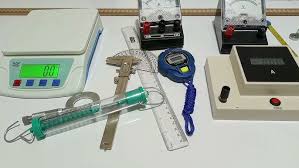There is always a small difference between a measured value and the actual value.
This occurs regardless of the accuracy in the measuring instrument. Measured values are then said to be the approximations or estimates of the actual values.
The difference between the actual value and the measured values is referred to as the error.
Accuracy in measuring instruments
Measuring instruments are usually calibrated with markings. There is always a gap between two marking. If the measured objects fall between the two calibrated markings, we must estimate. The reason is, we cannot read the actual value.
Accuracy of a measuring instruments depends on the smallest units of measurements that is being used in the instrument. An ordinary ruler can measure lengths up to the nearest millimeter. This is because the smallest units of measurements used in a ruler is one millimeter.
If a length is 5.5 cm, it means it is nearer 5.5 cm than any other value on the ruler. However, the measurements is said to lie on the neighborhoods of 5.5 cm. This neighborhood is 5.45 cm and 5.55 cm.
5.45 cm is then said to be the lower limit while 5.55 cm is said to be the upper limit.
For a micrometer screw gauge, the smallest unit of measurements is 0.01 mm or 0.001 cm. A measurements given in centimeters from micrometer screw gauge will thus have three decimal places. For example 5.892 cm. This means the measurements is between 5.8915 cm and 5.8925 cm.
A micrometer screw gauge measures lengths to a higher degree of accuracy. This is due to the increased number of decimal places making it more precise compared to a ruler.
Absolute error
When a measuring instruments has the least units of measurements as 0.1 cm, measuring 7.5 cm causes the greatest possible error to be 7.55 cm -7.5 cm = 0.05 cm or 7.5 cm – 7.55 cm = -0.05 cm.
We are only interested in the size of the possible error. Therefore, we ignore the sign. We state the absolute error as 0.05 cm. thus, |-0.05| = |+0.05| = 0.05
in general, when the accuracy of the instrument is 0.1, the measured value n can be described as:
In other words, Absolute error is usually calculated as half of the smallest unit of measurements unless otherwise stated. For example if measurement is given as 7.612 cm, the smallest unit of measurements is 0.001 cm. the absolute error will thus be given as :
in this case, it should be:
Relative error
Errors involved in measuring small quantities has more effects than errors in large quantities. For example, an error of 0.05 m when measuring a length that is not more than 2 m is significant. This error can be large compared to the same error while measuring a length of 200 km.
Relative error is used to gauge error with respect to the measured value.
For example, the relative error for measuring 2 m will be given by:
The relative error when measuring 200 km would be :
The later error calculated is small enough and can be considered negligible compared to the size being measured.
Percentage error
percentage error is relative error expressed as percentage. That is;
in the case mentioned above, the first case will have percentage error given as:
the second case will have the percentage error given by:
Measurements with an error of 2.5% is less reliable compared to that with 0.000025%
Practice exercise
in each of the following, determine: upper limit, lower limit, absolute error, relative error and the percentage error:
(a) 60.70 Kg (b) 2.5 m (c) 6.5 cm (d)800.9 m (e) 800 m (f)16.295 m
Round off error
It is the difference between the rounded value and the original value before round off.
example if we round of 3.674 to two decimal places, we have round off error computed as follow:
value after round off = 3.67
3.674 – 3.67 = 0.004
Truncating error
Truncating is slashing off figures from numbers without rounding off:
for example, 345.7867844 can be truncated to 2 decimal places to give 345.78. If it was round off, it should be 345.79


Comments
One response to “Accuracy of measuring instruments”
[…] Introduction to measurement error […]